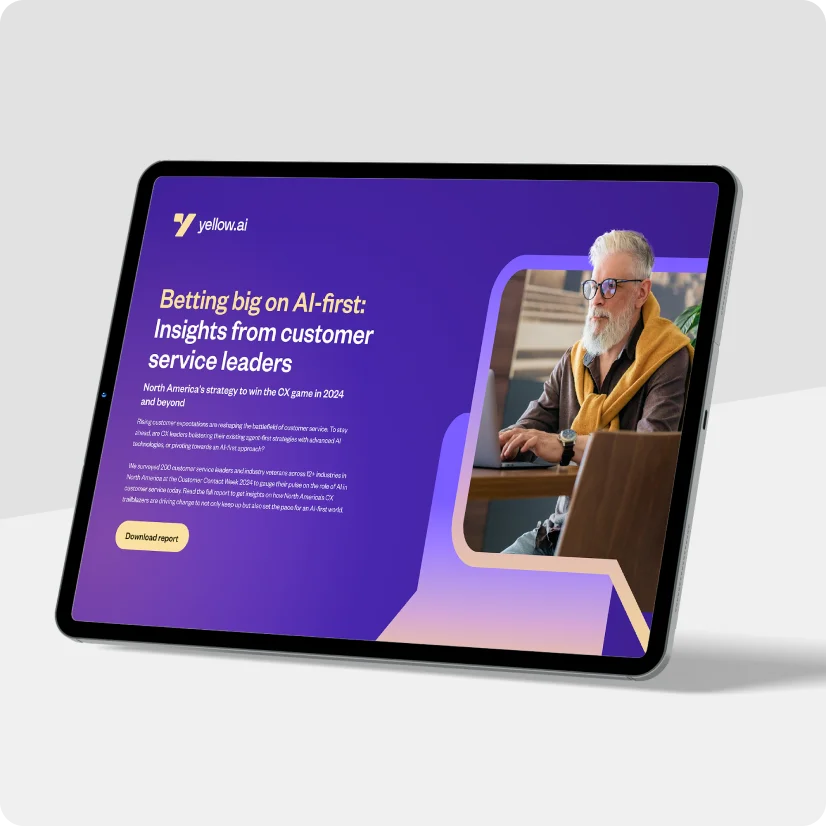Executive summary
Dive into the heart of what makes or breaks the modern customer experience with this snappy guide to the most revealing customer service stats of our time. From the eye-opening realities of customer expectations to the hard truths about the cost of a bad experience, these statistics are a wake-up call for any business looking to thrive.
This blog is the blueprint for future-proofing your customer service strategy in a world where loyalty is hard-won and easily lost.
Introduction
In today’s bustling marketplace, where your competitor is just a click away, stellar customer service is your lifeline. But don’t just take our word for it; the numbers speak louder than any marketing pitch ever could. Picture this: a world where AI doesn’t just solve problems but anticipates them, transforming the dreaded customer service call into a surprisingly pleasant part of the customer journey. Sounds like a pipe dream? Not so much.
Now, why should you, as a business, care about diving into a sea of statistics? Because each number is a piece of the puzzle in understanding what your customers are really telling you. Do not confuse these numbers as just cold, hard facts; they are the raw, unedited script of customer expectations, aspirations, and frustrations. This blog sifts through the noise and spotlights the stats that matter most to your bottom line. Read on as we navigate the twists and turns of customer service today, where AI meets empathy, and data drives not just decisions but relationships.
Related must-reads:
- Customer service trends to watch in 2024
- 15 Key customer service skills (How to develop them)
- 10 Great customer service experience examples in 2024
- What is customer service automation [+7 benefits]
General customer service insights
In an era where customer expectations shape the landscape of service delivery, businesses stand at a crucial juncture. They must adapt or risk becoming irrelevant. The power of understanding general customer service insights can be transformative, offering a compass for navigating the often-turbulent waters of customer satisfaction and engagement.
Customer expectations
- A staggering 93% of customer service teams concur that customer expectations are climbing skyward. It isn’t surprising when you consider that eight in ten people frequently encounter less-than-stellar service experiences.
- The digital transformation has further fueled these expectations, with 71% of customer support leaders noting a significant uptick in contact volumes post-February 2020.
- Despite the pandemic, 74% of U.S. consumers reported unsatisfactory service encounters. It underscores the critical need for businesses to elevate their service game.
Loyalty and service
- The quest for loyalty in a sea of choices highlights a pivotal insight: 68% of consumers expect every interaction to be personalized. It echoes the shift towards more customer-centric service models.
- This personalized approach is becoming the bedrock of customer loyalty, with 91% of customer service reps witnessing team expansions to better cater to this need.
- Moreover, the push towards a more connected world has seen 75% of customer service team leaders lean into cloud technology. That enables more agile and responsive service paradigms.
Key takeaways for businesses
- Invest in understanding and meeting your customers’ heightened expectations. It involves leveraging technology and data analytics to offer personalized experiences that resonate on an individual level.
- Cultivate loyalty through exceptional service by responding to needs and anticipating them. It might mean expanding your team or embracing cloud solutions to ensure you’re always within reach when your customers need you.
- Prepare for the future by adapting to changes in customer behavior and preferences. Consumers increasingly value brands that contribute positively to the world. Align your customer service values with broader societal goals could be a significant differentiator.
Brand loyalty and retention
The battle for brand loyalty is fierce, and in many ways, it’s a marathon, not a sprint. How does customer service impact loyalty, and is it more important than price? Let’s decode the stats that draw the line between fleeting interactions and lasting relationships.
Impact on loyalty
- An astonishing seven out of ten (70%) customers have severed ties with brands due to subpar customer service, underscoring the critical role of customer interactions in maintaining loyalty.
- Beyond basic service expectations, eight in ten (80%) consumers desire brands to contribute positively to societal issues. It indicates that today’s loyalty extends beyond transactions to shared values and community impact.
- With 68% of customers stating that positive experiences on messaging platforms significantly boost their brand loyalty, it’s evident that the channels and quality of communication are pivotal in retaining customers.
Service vs Price
- The debate between service and price as loyalty drivers lean heavily towards service, with 68% of consumers willing to pay a premium for products and services from brands known for their exceptional customer service.
- It is further evidenced by the fact that 86% of consumers transition from one-time buyers to long-term brand advocates after experiencing outstanding customer service. It highlights the immense ROI of investing in customer care.
- Moreover, businesses focusing on superior customer service can outperform their market, growing revenues by 4% to 8% above their competitors. It proves that excellent service is not just a cost center but a potent revenue driver.
Key takeaways for businesses
- Prioritize personalized and high-quality customer interactions to foster brand loyalty. In an age where consumers have endless choices, exceptional service can be your strongest differentiator.
- Align your brand values with societal contributions to resonate with modern consumers who look for more than just transactions. Engaging in causes and community support can significantly enhance brand loyalty.
- Leverage technology to enhance service quality and accessibility. Use platforms and channels preferred by your customers to provide seamless and satisfying experiences.
- View customer service not as an expense but as an investment in your brand’s future. The statistics are clear: spending on customer service is spending on growth, retention, and profitability.
3. Digital transformation in customer service
The digital revolution has irrevocably changed the face of customer service. As businesses pivot towards digital-first strategies, understanding consumer preferences for digital channels and self-service options becomes paramount.
Related read: AI in customer service – Benefits and examples
Preference for digital channels
- As digital channels like social media become increasingly integral to customer service, 87% of customer service representatives have noted a spike in their usage since the pandemic began. This shift isn’t transient; it’s a permanent transformation in the landscape of customer interactions.
- The utilization of customer portals illustrates this trend, with 64% of customer service teams leveraging them against 84% of customers who prefer these digital gateways for service and support.
- The digital wave has swept across all aspects of customer service, with 83% of customers expressing a willingness to engage with community forums for self-service support. This digital preference underscores the need for businesses to diversify their customer service channels. They must embrace digital platforms not as an afterthought but as a cornerstone of their strategy.
- Further emphasizing this shift, 78% of customers now expect brands to offer self-service options over traditional channels. This transition is a clear message from consumers seeking empowerment in their interactions with brands.
- Despite the digital appetite, a frustration emerges: 28% of consumers find it challenging to access simple yet hard-to-find information. This gap highlights the critical importance of not just digitalizing customer service but optimizing it for ease of access and user experience.
Rise of self-service
- The self-service phenomenon is more than a convenience; it’s a preference. 69% of consumers attempt to solve their issues independently before reaching out for help. It showcases a significant opportunity for businesses to cater to this DIY mindset. Yet, the stark reality is that less than a third of companies offer comprehensive self-service options such as knowledge bases, indicating a mismatch between consumer expectations and business offerings.
- Knowledge bases stand out as the preferred self-service channel, with 66% of customer service teams utilizing them. However, this pales in comparison to the 82% of customers who turn to knowledge bases for solutions. It suggests a crucial area for investment and improvement for businesses aiming to meet customer expectations.
- Consistency across channels is non-negotiable for 75% of customers, who demand a seamless experience whether they interact online, in person, or over the phone. This demand for consistency extends to the expectation of real-time responses, with 64% of customers favoring businesses that can meet their needs instantly.
Related read: Self customer service: Navigating the new era of empowered consumers
Key takeaways for businesses
To thrive in this digital-first environment, businesses must align their customer service strategies with their customers’ evolving preferences. It entails expanding digital channels and self-service options and ensuring these platforms are intuitive, easily accessible, and capable of providing consistent, real-time support.
4. Impact of poor customer service
The consequences of poor customer service ripple far beyond a single negative interaction. They can lead to customer churn and a tarnished brand reputation. Grasping the full impact can spur organizations to take preemptive action and make strategic improvements.
Customer churn
- The global economy feels the sting of subpar customer service, with businesses hemorrhaging an astonishing $4.7 trillion annually due to negative customer experiences. This staggering figure underlines the direct correlation between the quality of customer service and a company’s financial health.
- The consequences of poor service extend beyond immediate financial losses. With 65% of customers switching brands due to a single bad experience, the threat of customer churn is palpable. This trend is a clarion call for businesses to exceed customer expectations at every turn.
- After more than one poor experience, about 80% of consumers are ready to jump ship to a competitor. This statistic is a sobering reminder that customer loyalty is not guaranteed. Instead, it must be earned and re-earned with every interaction.
Negative feedback
- In the age of social media and online reviews, negative feedback can amplify quickly, casting a long shadow over a brand’s reputation. 72% of U.S. consumers have penned a review for a local business. It indicates that customer voices are louder and more influential than ever.
- The ripple effect of a single negative experience is profound. It takes 12 positive customer experiences to compensate for one negative encounter. This imbalance showcases the outsized impact of negative feedback on a business’s reputation and customer relationships.
- Surprisingly, 49% of customer complaints on social media go unanswered. It underscores a significant missed opportunity for businesses to engage with dissatisfied customers and potentially mitigate the damage.
Key takeaways for businesses
- Prioritizing effective and speedy resolutions to customer issues can drastically reduce the likelihood of churn. By focusing on enhancing their customer service experience, companies could see their profits soar.
- Engaging with negative feedback transparently and constructively helps in retaining customers. Furthermore, it can also turn detractors into promoters, leveraging their influence to attract new customers.
5. Demographic insights
Understanding the nuanced preferences of different demographics, particularly Millennials and Gen Z, is critical for tailoring customer service strategies that resonate on a deeper level and foster loyalty.
Millennials: The digital pioneers
- Representing a significant portion of today’s workforce and consumer base, Millennials have been at the forefront of digital transformation. 61% of Millennial consumers in the United States are open to and willing to pay more for quality customer service. This readiness to invest more for better service underscores the importance they place on customer experience as part of the value proposition.
- Their communication preferences reveal a shift from traditional customer service channels. With 35% preferring email for support interactions, Millennials exemplify the digital-first approach. It favors convenience and documentation over immediacy.
- Moreover, 62% of Millennials turn to unofficial knowledge bases for self-service options. This statistic highlights a key trend: the Millennial inclination towards independence and self-reliance in resolving service issues, alongside a desire for 24/7 accessibility.
Gen Z: The empathy-driven digital natives
- Gen Z, having grown up in a fully digital era, accounts for an estimated 40% of global customers. Their influence extends beyond sheer numbers; their expectations around technology and social responsibility are reshaping how brands interact with their customers.
- This demographic values empathy significantly, with 14% of Gen Zers emphasizing the importance of empathetic customer support. This figure surpasses both Millennials and Baby Boomers. This insight reveals a critical aspect of their customer service expectations: human connection matters, even in a digital world.
- With 63% stating that mobile experience is crucial for customer satisfaction, Gen Z’s preferences highlight the need for seamless, responsive mobile interfaces. Additionally, 77% expect brands to innovate in delivering existing products. It indicates a preference for digital versions of traditionally in-person experiences.
- The landscape of B2B tech buying is undergoing a generational shift. With 60% of buyers now Millennials and an emerging 2% from Gen Z, this change signifies a broader transformation in procurement strategies.
Key takeaways for businesses
Businesses aiming to thrive in the current market must tailor their customer service and product offerings to align with the unique preferences and values of Millennials and Gen Z. By recognizing the importance of quality service, empathetic interactions, digital accessibility, and innovative solutions, brands can forge lasting connections with these pivotal consumer segments. Adapting to their expectations is a blueprint for enduring relevance in the digital age.
6. The role of feedback and reviews
In a world where consumers are increasingly relying on others’ experiences, feedback and reviews have become gold dust for businesses. They help build trust, improve services, and enhance customer satisfaction.
Influence of reviews
- In an era where 87% of customer service representatives note an uptick in digital channel use, including social media, during the pandemic, the impact of reviews has magnified. Consumers passively consume information and actively seek it, with more than 70% believing in the collective power of companies to streamline their experience.
- The digital transformation has led to the average consumer using nine channels for browsing and purchasing. It highlights the omnipresence of brand interactions. With such a complex ecosystem, reviews become a critical touchpoint for potential customers, guiding their journey from consideration to conversion.
Feedback for improvement
- The statistics are clear: 90% of consumers rate immediate responses as critical when they have a customer service question. This urgency underscores the necessity for businesses to adopt a proactive stance and engage customers through their preferred channels.
- Yet, the challenge of managing multi-channel communication is evident, with 71% of customer service employees finding it difficult to meet customer needs due to channel switching. This complexity doesn’t diminish the value of feedback; instead, it amplifies the need for integrated solutions that capture and act upon customer insights across platforms.
- The expectation for seamless experiences is highlighted by 86% of consumers, who anticipate consistent communication across multiple channels. Businesses that understand and implement this seamless integration meet and exceed customer expectations and foster loyalty and advocacy.
Key takeaways for businesses
- Remember, feedback is not merely about pinpointing flaws. It is about uncovering opportunities. With nearly 90% of consumers placing their trust in companies rated “very good” by their peers, the positive ripple effect of high-quality service is undeniable. Transforming feedback into actionable insights allows businesses to rectify issues and innovate in ways that resonate with their customer base.
- The fact that “a customer is four times more likely to switch to a competitor if the problem is service-based” is a stark reminder of the stakes involved. In the pursuit of excellence, businesses must view every piece of feedback as a stepping stone toward creating an unparalleled customer experience.
7. Social media as a customer service tool
Social media has transcended its role as a mere platform for social interaction to become a pivotal customer service tool. Businesses that leverage this channel effectively can enhance engagement, resolve issues promptly, and build stronger relationships with their audience.
Related read: An effective how-to guide for social media customer service
Social media expectations
- A staggering 48% of consumers expect a response to their queries and complaints on social media within 24 hours. It underscores the need for businesses to be agile and responsive.
- Ignoring this expectation is no longer an option, as even casual social media users constitute over half (54%) of the platform’s populace, research products, and services. It indicates the vast influence of social media on purchasing decisions.
- Interestingly, 18% of consumers have even tighter expectations, anticipating a reply within just one hour. This sense of urgency demonstrates the premium users’ desire for swift and efficient customer service through social media channels.
Public perception
- A vast majority, 79%, of American internet users are active on Facebook. That makes it clear that social media platforms offer a fertile ground for customer interaction. This presence is a testament to how social media shapes the public’s perception of a brand.
- The potency of social media is further highlighted by the engagement rates of micro-influencers, who, despite having fewer than 500,000 followers, boast conversion rates six times higher than traditional Facebook ads. This stat is a clarion call for businesses to leverage their direct interactions and also the influential power of social media personalities to sway public opinion positively.
- It is also worth noting that 95% of adults aged 18-34 are likely to follow a brand through social media channels. It illustrates the pivotal role these platforms play in building and maintaining brand loyalty among younger demographics.
Key takeaways for businesses
- Businesses need to adapt to the reality that social media is not a monolithic entity; each platform has its nuances and requires a tailored approach to engagement. Given that companies are now responding faster, with 59% of social media responses occurring within 15 minutes, the bar for customer service excellence is continuously being raised.
- Engagement isn’t just about addressing complaints or queries; it’s about creating a dialogue. Companies that understand this dynamic are the ones that turn casual followers into brand advocates. Therefore, embracing social media’s conversational nature is essential for survival in the digital age.
8. Advancements in technology
The relentless pace of technological advancements has ushered in a new era of customer service characterized by AI-driven solutions and automated systems designed to enhance efficiency and personalize customer interactions.
AI and automation
- One in three decision-makers leveraging AI highlights its critical role in predicting customer needs and delivering personalized experiences, pinpointing it as a vital driver of return on investment. This insight illuminates the power of AI in enhancing customer satisfaction and its pivotal role in business strategies.
- By classifying service issues and automatically routing customer contacts, AI is boosting contact center productivity by 1.2 hours a day. This leap in efficiency allows agents to focus on complex tasks, elevating the overall quality of service.
- McKinsey’s analysis reveals that an AI-powered omnichannel contact center could manage nearly two-thirds of customer service tasks and up to 70% of contacts. This staggering figure highlights the vast potential of automation in streamlining operations and enhancing customer engagement.
- 79% of businesses recognize the imperative of automation in customer experience strategies. It emphasizes the shift towards more agile and responsive service models.
Chatbots
- Chatbots have seen a surge in adoption, with 38% of B2B decision-makers stating their organization used chatbots in 2020. It marks a 67% increase from 2018. This growth trajectory reflects the increasing reliance on chatbots to meet customer service demands efficiently.
- However, the path is not without its hurdles. Some customers report poor service experiences with chatbots. It signals a need for refinement in how these tools understand and process user requests.
- Despite the technological leaps, 71% of Americans still prefer human interaction over chatbots or automated processes. That underscores the importance of maintaining a personal touch in customer service.
- Interestingly, Millennials have expressed a preference for live chat over other communication channels. It highlights demographic differences in technology adoption and expectations.
Key takeaways for businesses
- The integration of AI and automation into customer service offers promising advantages, including enhanced efficiency and personalized customer experiences. However, the challenge lies in balancing technological capabilities with the nuanced understanding that human agents bring to the table.
- As we navigate this new frontier, it’s clear that the future of customer service lies in choosing between human agents and technology and in harmonizing the two to deliver service that is empathetic and personalized.
9. Expert opinions and future trends
As we stand on the brink of a new decade, expert insights and predicted trends in customer service provide a roadmap for businesses eager to stay ahead of the curve. The fusion of technology, personalized service, and strategic engagement will redefine the benchmarks of customer service excellence.
Future of customer service
- Omnichannel experience: The seamless integration of multiple communication channels will continue to define customer service excellence. Companies must strive for consistency and accessibility across all platforms to meet the modern consumer’s expectations.
- Personalization at scale: Utilizing customer data to tailor experiences will set businesses apart. Personalized interactions enhance satisfaction and also deepen customer relationships, driving loyalty and repeat business.
- Workforce flexibility: The shift towards remote and hybrid work models demands investment in technology that supports collaboration and connectivity. Flexible work arrangements contribute to agent satisfaction, which, in turn, reflects in the quality of service delivered.
- AI and chatbots: Artificial intelligence and chatbots are transforming customer service by streamlining operations and providing instant support. By automating routine inquiries, these technologies allow human agents to focus on complex issues that require a personal touch.
- Agent happiness: Recognizing the pivotal role of customer service agents, businesses must prioritize their well-being. Satisfied agents are more likely to deliver exceptional service, thereby enhancing the overall customer experience.
- Online reputation management: Engaging with customer reviews is critical for brand image. Prompt, thoughtful responses to feedback demonstrate a company’s commitment to customer satisfaction and continuous improvement.
The final thoughts
As the sun sets on today’s customer service paradigms, a new dawn beckons businesses with the promise of uncharted territories ripe for exploration. The statistics and insights we’ve navigated together are a compass pointing toward where we need to go. In this journey, the fusion of technology and human empathy emerges as an imperative for crafting experiences that resonate deeply and enduringly with customers.
Embrace this as your clarion call. The future belongs to those who listen with intent to the voices of their customers, leveraging every byte of data and every spark of technological innovation to tailor services that are as personal as a handwritten letter yet as efficient as the slickest algorithm. As you step forward, remember the path to excellence in customer service is both an art and a science—demanding a balance that only the bold will dare to strike. Here’s to those who will lead the charge, shaping the future one satisfied customer at a time.


























